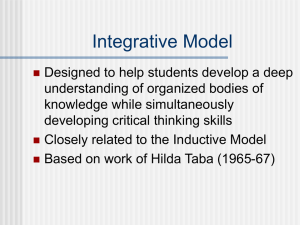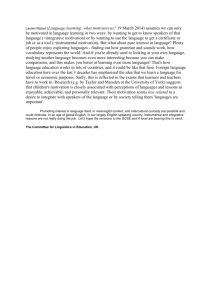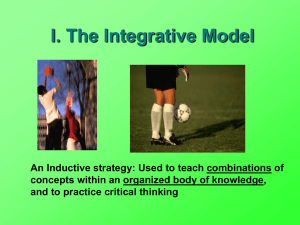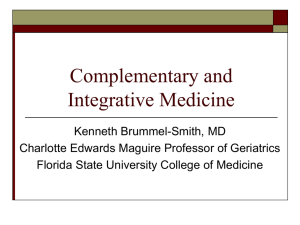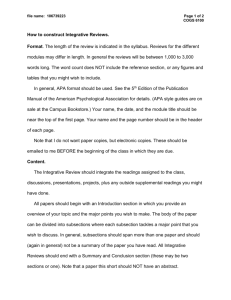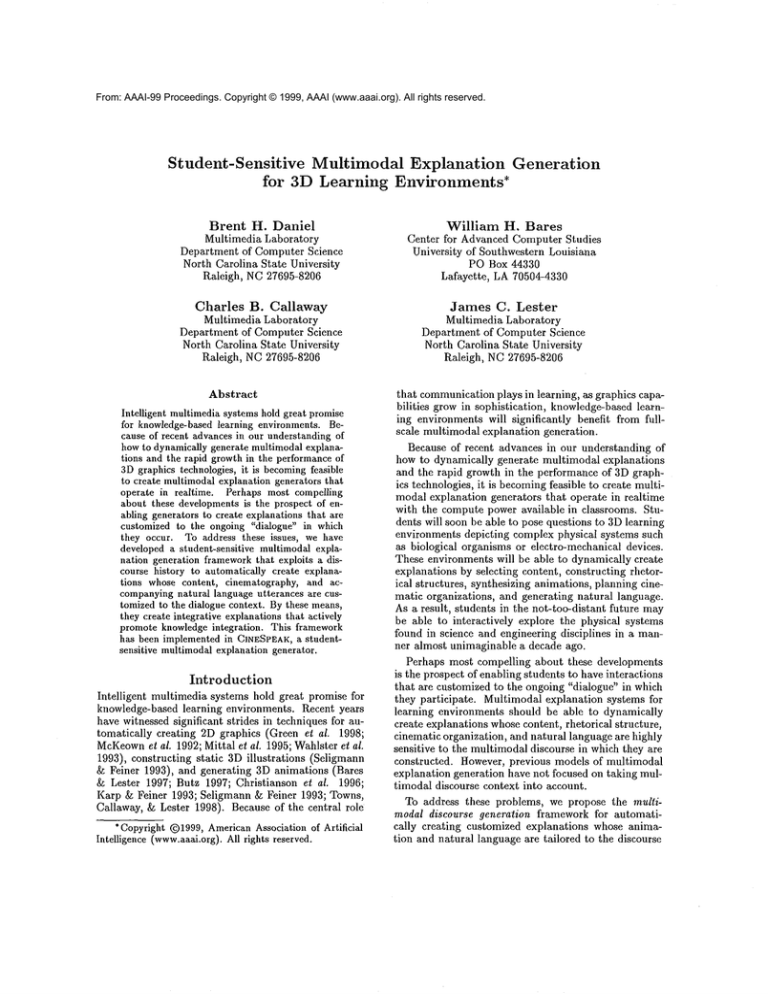
From: AAAI-99 Proceedings. Copyright © 1999, AAAI (www.aaai.org). All rights reserved.
Student-Sensitive
Multimodal Explanation Generation
for 3D Learning Environments*
Brent
H. Daniel
Multimedia Laboratory
Department of Computer Science
North Carolina State University
Raleigh, NC 27695-8206
William
H. Bares
Center for Advanced Computer Studies
University of Southwestern Louisiana
PO Box 44330
Lafayette, LA70504-4330
Charles
B. Callaway
Multimedia Laboratory
Department of Computer Science
North Carolina State University
Raleigh, NC 27695-8206
James C. Lester
Multimedia Laboratory
Department of Computer Science
North Carolina State University
Raleigh, NC 27695-8206
Abstract
Intelligent multimediasystems hold great promise
for knowledge-basedlearning environments. Because of recent advances in our understanding of
howto dynamically generate multimodal explanations and the rapid growth in the performanceof
3Dgraphics technologies, it is becomingfeasible
to create multimodalexplanation generators that
operate in realtime. Perhaps most compelling
about these developmentsis the prospect of enabfing generators to create explanations that are
customized to the ongoing "dialogue" in which
they occur. To address these issues, we have
developed a student-sensitive multimodal explanation generation frameworkthat exploits a discourse history to automatically create explanations whose content, cinematography, and accompanyingnatural language utterances are customized to the dialogue context. By these means,
they create integrative explanations that actively
promote knowledge integration. This framework
has been implementedin CINESPEAK, a studentsensitive multimodalexplanation generator.
Introduction
Intelligent multimedia systems hold great promise for
knowledge-based learning environments. Recent years
have witnessed significant strides in techniques for automatically creating 2D graphics (Green et al. 1998;
MeKeown
et al. 1992; Mittal et al. 1995; Wahlster et al.
1993), constructing static 3D illustrations (Seligmann
& Feiner 1993), and generating 3D animations (Bares
& Lester 1997; Butz 1997; Christianson et al. 1996;
Karp & Feiner 1993; Seligmann & Feiner 1993; Towns,
Callaway, &; Lester 1998). Because of the central role
*Copyright @1999,AmericanAssociation of Artificial
Intelligence (www.aaal.org).All rights reserved.
that communicationplays in learning, as graphics capabilities grow in sophistication, knowledge-basedlearning environments will significantly benefit from fullscale multimodal explanation generation.
Because of recent advances in our understanding of
how to dynamically generate multimodal explanations
and the rapid growth in the performance of 3D graphics technologies, it is becomingfeasible to create multimodal explanation generators that operate in realtime
with the compute power available in classrooms. Students will soon be able to pose questions to 3Dlearning
environments depicting complex physical systems such
as biological organisms or electro-mechanical devices.
These environments will be able to dynamically create
explanations by selecting content, constructing rhetorical structures, synthesizing animations, planning cinematic organizations, and generating natural language.
As a result, students in the not-too-distant future may
be able to interactively explore the physical systems
found in science and engineering disciplines in a manner almost unimaginable a decade ago.
Perhaps most compelling about these developments
is the prospect of enabling students to have interactions
that are customized to the ongoing "dialogue" in which
they participate.
Multimodal explanation systems for
learning environments should be able to dynamically
create explanations whosecontent, rhetorical structure,
cinematic organization, and natural language are highly
sensitive to the multimodal discourse in which they are
constructed. However, previous models of multimodal
explanation generation have not focused on taking multimodal discourse context into account.
To address these problems, we propose the multimodal discourse generation framework for automatically creating customized explanations whose animation and natural language are tailored to the discourse
(a) Shot of the chloroplast
Figure 1: The CINESPEAK
multimodal generator
in which they occur. In particular,
this framework
is designed to produce integrative multimodal explanations whose content and form are optimized for enabling students to integrate new knowledge into their
current knowledge of the domain. By exploiting a discourse history of recently generated multimodal explanations and employing integrative multimodal explanation planning strategies,
the framework dynamically produces extended animations whose content, cinematography, and accompanying natural language utterances are customized to the context in which they are
generated. It has been implemented in CINESPEAK, a
student-sensitive
multimodal explanation system consisting of a media-independent explanation planner, a
visuo-linguistic mediator, a 3D animation planner, and
a realtime natural language generator with a speech
synthesizer. CINESPEAK
has been used in conjunction
with PLANTWORLD
(Figure 1), a prototype 3D learning environment for the domain of botany, to generate
realtime multimodal explanations.
Integrative
Multimodal
Explanations
The context in which multimodal explanation generators for learning environments will operate consists of
a complex matrix of knowledge activated by studentsystem exchanges. Multimodal explanation systems
should therefore exploit this context to assist students
in incorporating new knowledge into their existing set
of beliefs about the domain. In their landmark work
on reading comprehension, Adamsand Bruce set forth
rhetorical requirements for authors who wish to clearly
communicate with their readers (Adams & Bruce 1982).
The task of constructing an effective linguistic message consists of (1) correctly guessing what sorts
of related knowledge the intended readers already
have, (2) producing expressions that will evoke appropriate subsets of that knowledge, and (3) presenting those expressions in a way that will induce
(b) Food sugars traveling
in the
down the phloem
PLANTWOR,LD learning
environment
readers to interrelate the evoked knowledge into a
structure that most nearly captures the meaning
intended. (Adams ~ Bruce 1982)
Analogously, multimodal explanation systems should
construct integrative
explanations whose content,
rhetorical structure, cinematography, and natural language promote knowledge integration. They should follow what have been termed epistemological gradients,
which are "relations between the to-be-communicated
and whatever guesses are available about the hearer’s
knowledge state" (Suthers 1993). Computationalizing
such integrative desiderata entails providing solutions
to each of the following problems:
¯ Integrative Content and Structure: The knowledge
selected for presentation must not be determined in
a vacuumbut rather must take into account the discourse in which it will be presented (Moore 1995).
¯ Integrative Animation Synthesis: The visual elements
of animations must be selected so that students can
make visual connections between the imagery associated with currently understood concepts and new
ones. Optimizing for knowledge integration can be
significantly aided by showing new objects/processes
in the physical context of familiar ones and by transitioning from known to new concepts.
¯ Integrative Natural Language Generation: Each of
the traditional tasks of generating natural language,
e.g., sentence planning and surface generation, must
be performed in such a manner that the conceptual
relations between familiar concepts and new concepts
are communicated verbally.
Planning
Customized
Explanations
Generating integrative multimodal explanations hinges
on dynamically performing each of the tasks above in a
manner that takes into account the student’s evolving
Discourse
Context
)
¯ = BaseNetwork
Connecting
Network
Target
Network
Figure 2: Integrative
Explanation
interests and knowledge of the domain. To do so, explanation systems must be able to (1) recognize opportunities in the discourse for generating integrative explanations and (2) construct explanations’ content and
organization (including rhetorical, visual, and linguistic
structure) in such a manner that they provide multiple
links in multiple modalities from familiar concepts to
new concepts. Weformalize this notion of multimodal
integrative explanations in a graph-theoretic manner.
This framework defines three networks of relevant concepts and relations for integrative multimodal explanation generation (Figure 2). The target network is the
set of concepts and relations that an explanation generator seeks to communicate to respond to the student’s
question. The base network is the set of concepts and
relations that model what the student already understands and are relevant in some way to the target. The
connecting network is the set of concepts and relations
that relate the target to the base.
Identifying
Target
and Base Networks
The integrative framework identifies
the target and
base networks in different ways. Employingtraditional
content determination techniques, e.g., (Moore 1995;
Suthers 1993), target networks are selected based on the
the student’s question type and the concept of interest.
To illustrate, when requested to explain a process, the
explanation system inspects the knowledge base to obtain the location, principle actors, and sub-events
of the specified process. In contrast to target networks,
which are determined by "context-insensitive"
strategies, base networks must be cognizant of the ongoing
discourse and students’ interests. This knowledge is
provided by two knowledge sources:
¯ Multlmodal Discourse History: The explanation
system will ultimately construct explanation trees
whose leaves are annotated with media realization
specifications (animation and/or natural language)
for each proposition to be communicated. To track
the ongoing explanation session, it maintains the sequence of trees for the past n explanations it has
generated. This provides a rich, structured representation of (1) concepts the student has expressed interest in, (2) the communicationstrategies that have
been employed to explain these concepts, and (3) the
order in which the explanation session has unfolded.
* Conceptual Centrality
Specification:
The explanation system also maintains a centrality concept
that indicates which concept the student would most
benefit from new knowledge being "integrated into."
For example, a high school student studying a curricular unit on food production in the domain of botanical anatomy and physiology might wish to have new
information related to photosynthesis.
Creating
Connecting
Networks
For a given concept in the target network, the explanation system must obtain the concepts in the connecting
and base networks that are appropriate for the student’s
current knowledgestate. Typically, for a concept in the
target network, there are a plethora of connections to
other concepts. Moreover, many subsets of concepts
in a knowledge base may be known to a given student
at a particular juncture in a learning session. Hence,
there may be many connections between concepts in
the target network and concepts that are familiar to
the student. Presenting arbitrary connections between
new concepts and familiar concepts would result in confusing explanations that meander aimlessly. To combat
this, the explanation system finds the connecting network by searching for the following categories of connections between (1) concepts T in the target network and
hislorical concepts H in the base network or (2) concepts T in the target network and central concepts C
in the base network.
¯ Base Super-Structure
- Triggering Connection: Some H or C is a superstructure of some concept T.
- Integrative Visual/verbal Specifications: ((Show
H/C), (Say H/C super-structural-relationship
T)).
- Sequencing: Integrative --~ Target
- Example: To generate an explanation of xylem, the
system will note that the tree, a superstructure,
has recently been discussed. It will therefore show
the tree and say that the xylem is part of the tree.
¯ Base Sub-Structure
- Triggering Connection: Some H or C is a substructure of some concept T.
- Integrative Visual/verbal Specifications: ((Show
T), (Say H/C sub-structural-relationship
T)).
- Sequencing: Integrative --+ Target
- Example: To generate an explanation of a leaf, the
system will note that the stomata, a part of the
the leaf, is of central interest to the student. It
will therefore showthe leaf and say that the leaf
contains the stomata.
¯ Base Categorical
- Triggering Connection: Either some H has the
same superstructure as T, or some C has the same
superstructure as T.
- Integrative Visual/verbal Specifications: ((Show
super-structure
H/C T), (Say H/C categoricalrelationship T)).
- Sequencing: Integrative -~ Target
- Example: To generate an explanation of a chloroplast, the system will note that the stomata, which
is also a part of the leaf, has recently been discussed. It therefore shows the leaf and then says,
"Like the stomata, the chloroplasts are located in
the leaf."
¯ Recent
Pre-Temporal
- Triggering Connection: H and T are involved in
the same process and the role of T in the process
occurs immediately before the role of H in the process.
- Integrative Visual/verbal Specifications: ((Show
(Role-0f T wrt P)) (Say Temporal-l%elation (RoleOf T wrt P) (Role-Of H wrt P))), where P is
process involved in the roles of H and T.
- Sequencing: Target --* Integrative
- Example: To generate an explanation of chloroplasts, if the system has recently explained the
role of phloem, it will first explain the basics of
the role chloroplasts perform and then, to preserve
appropriate temporal ordering, turn to the integrative knowledge. The latter will be communicated by showing the role of the chloroplasts and
verbally explaining that the role of phloem (food
sugar distribution) occurs directly after the role of
the chloroplast (food sugar production) by generating the sentence, "After the chloroplasts produce
food sugars, the food sugars are distributed by the
phloem."
¯ Recent
-
Post-Temporal
Triggering Connection: H and T are involved in
the same process and the role of T in the process
occurs immediately after the role of H in the process.
- Integrative Visual/verbal Specifications: ((Show
(Role-0f T wrt P)) (Say Temporal-Relation (RoleOf T wrt P) (Role-Of H wrt P))), where P is
process involved in the roles of H and T.
- Sequencing: Integrative --* Target
- Example: To generate an explanation of xylem, if
the system has recently explained the role of the
chloroplast, it will showthe role of the xylem and
verbally explain that the role of the xylem (water and mineral transport) occurs directly before
the role of the chloroplast (food sugar synthesis)
by generating the sentence, "Before the chloroplast
can produce food sugars, water and minerals must
enter the chloroplast from the xylem."
¯ Recurring
Target
- Triggering Connection: H and T are identical (H
was discussed initially in low detail.)
- Integrative Visual/verbal Specifications: ((Show T)
(Say T :higher-detail))
- Sequencing: Increased detail.
- Example: If the chloroplast was recently discussed
and the student asks about it again, the system
will generate a more detailed explanation that describes more specific layers in the process structure. In this case, it will include animated behaviors and utterances communicating the details of
glucose production while relating them to the previous explanation, including narration such as, "As
you saw earlier, chloroplasts produce food sugars
for the plant."
¯ Central
Super-Process
- Triggering Connection: C is a super-process of T,
i.e., T is a "step" of C.
- Integrative Visual/verbal Specifications: ((Show
(location C)) (Say Super-Process-Relationship
T))
- Sequencing: Integrative --* Target
- Example: If the student (or the learning environment) has noted that photosynthesis is currently of
central interest to the student and the student asks
about the light reactions, the system will show the
location of photosynthesis (the leaf) and say that
the light reactions are a step of photosynthesis.
¯ Central
Sub-Process
- Triggering Connection: C is a sub-process of T,
i.e., C is one of the "steps" of T.
- Integrative Visual/verbal Specifications: ((Show
(location T)) (Say Sub-Process-Relationship C
- Sequencing: Integrative ~ Target
- Example: If the learning environment asserts that
in the current unit on the Calvin Cycle, new information should be explained in relation to the dark
reactions, when the student asks about photosynthesis, the explanation system shows the location
of photosynthesis (the leaf) while it explains that
the dark reactions are a step of photosynthesis.
Student-Sensitive
Explanation
Multimodal
Architecture
In the muttimodal discourse generation framework (Figure 3), explanation construction begins when a student
poses a question about a particular concept in the domain. For example, while perusing a 3D visualization
of the leaf, the student might becomecurious about the
chloroplast and ask about its physiological role. When
__
r
~]
rI
StudentSensitive
/
(I
ExplanatlonPlanner
s:-~.-
"
Student
\
::1
3DAnimation
P,.....
NaturalLanguage~.
i
II ~ .... ,or
--0
-- -I>
Figure 3: The student-sensitive
tion architecture
multimodal explana-
she poses a question, the student-sensitive explanation
generator operates in three interleaved phases to construct an integrative multimodal explanation:
1. Integrative
Explanation Planning: By inspecting the discourse context, which is represented by
the discourse history and the current centrality concept, it selects the student-sensitive content, i.e., the
propositions in the target, base, and connecting networks, and rhetorically organizes them.
Animation Planning: To visually
2. Integrative
communicatethe selected integrative content, the animation planner directs the student’s attention along
Suthers’ "epistemological gradients" by (a) selecting
relevant 3D models, (b) selecting relevant 3D motion
paths, and (c) issuing camera directives to the virtual
camera.
Natural Language Generation:
To
3. Integrative
verbally communicate the selected integrative content, the natural language generator (a) sends the
propositions to a sentence planner that creates full
sentential specifications, and (b) sends the resulting sentential specifications to a unification-based
systemic-functional surface generator.
To construct explanation plans, the system consults
the discourse history, extracts relevant propositions
from the knowledge base, and organizes them into an
explanation tree. The discourse history is represented
as a sequence of the n previously generated explanation plans; centrality concepts simply specify a particular concept. The planner first selects the concepts for
the target network as described above. Next, it consults
the discourse history and the current centrality concept.
Together, these are used to identify candidate concepts
for the base network. It then inspects the triggering
connections to identify the most useful connective relations between concepts in the discourse history and
concepts in the target network. The net result of this
phase is a media-independent explanation plan.
Finally, the 3D animation specifications and the natural language specifications of the explanation plans are
passed to the media realization engines. The 3D animation specifications are passed to the animation renderer (Bares & Lester 1997; Towns, Callaway, & Lester
1998), while the linguistic specifications are passed to
the natural language generator’s sentence planner (Callaway & Lester 1995) and surface generator (Elhadad
1992). The text constructed by the latter is passed
to a speech synthesizer. Visualizations and speech are
synchronized in an incremental fashion and presented
in atomic presentation units as dictated by the structure of the initial media-independent plan. Both are
presented in realtime within the 3D learning environment. The discourse history is then updated to include
the newly constructed explanation plan. Both the animation planner and the naturM language generation
system are products of long-term research in our laboratory. Below we briefly overview their operation.
Integrative
Animation
Planning
Given a set of show communicative goals in an explanation plan, the animation planner must construct an
animation that visually presents the propositions in the
target, base, and connecting networks. Planning animated explanations is a synthetic process of selecting
and organizing 3D models, the 3D behaviors they will
exhibit, and the camera planning directives that will be
used to plan the movementsof the virtual camera that
fihns the action. All of these decisions must take into
account the content and organization decisions made
during the integrative explanation planning phase:
1. 31) Model and Behavior Selection: Given a query
which specifies a question type, e.g., (explain-role
. ?T), and a target concept, e.g., stomata, the animation planner uses the ontological indices of the
knowledgebase to retrieve the relevant concept suite.
Indicating the most relevant visual elements, a concept suite is defined by a sequence of concepts, each
of which is either an object, e.g., Chloroplast or a
process, e.g., Phol;osynthesis, annotated with their
associated 3D models and 3D behaviors. 3D models
indicate the geometric properties of the objects, and
also contain annotations indicating texture maps.
Behavior models specify the motion paths that objects can follow in a scene relative to other objects.
2. Designing Focus Effects: Enabling a student to focus
her attention on the most salient characteristics of
the new knowledge presented in an animation is essential for pedagogical reasons. This central feature
of integrative explanations is provided by the animation planner’s ability to introduce two categories
of visual markers: (1) it highlights objects depicting
new concepts, and (2) it introduces onscreen labels
to indicate the nomenclature.
3. Cinematography Planning: Through judicious camera shot selection, explanations can direct students’
attention to the most important aspects of a scene.
For example, while high and far shots present more
information, close-up shots are useful for centering
on a single subject (Mascelli 1965). To provide visual
context, it initially selects far shots for unfamiliar objects, unfamiliar processes, and tracking moving objects. It selects close-ups for presenting the details of
familiar objects.
Integrative
Natural
Language
Generation
To ensure that natural language expressions clearly
communicatethe integrative content specified for the
narration, the natural language generator uses specifications issued in the say nodes of explanation plans.
The propositions selected for generation include concepts and relations in the target, base, and connecting networks, which are then used to construct sentential specifications by the sentence planner (Callaway
Lester 1995). Because lexical choice has been performed
by this point, sentential specifications include all of the
open class lexemes and their linguistic roles. After the
sentence planner constructs functional descriptions, it
passes them to a unification-based surface generator
(Elhadad 1992) to yield the surface strings, which are
then passed to a speech synthesizer, and delivered in
synchronization with the actions of the associated 3D
visualization.
The
Implemented
Generator
The student-sensitive
multimodal discourse generation
framework has been implemented in CINESPEAK, a generator that constructs integrative explanations with 3D
animations and speech) Given queries about physical
phenomena,
CINESPEAK consults the discourse history,
invokes a library of integrative multimodal explanation
strategies, and creates animated explanations with accompanying natural language. The integrative multimodal explanation strategies,
the media-independent
explanation planner, and visuo-linguistic mediator were
implemented in the CLIPS production system. The 3D
animation planner was implemented in C++. The natural language generator was implemented in Harlequin
Lispworks and employs the FUF surface generator and
SURGE(Elhadad 1992), a comprehensive unificationbased English grammar. The animation renderer was
created with the OpenGLrendering library, and the
speech synthesis module employs the Microsoft speech
synthesizer. CINESPEAK 2operates in realtime.
101NESPEAK
is implemented in a networked computing
environment consisting of two PentiumPro 300s communicating via TCP/IPsocket protocols over an Ethernet. It’s
various modulesconsists of more than 60,000liues of Lisp,
++
CLIPS,
.
and (3
2Typical explanations last approximately 30 seconds. To
construct a typical explanation, CINESPEAK
(1) exhibits
an initial latency of less than 1 second, (2) conducts animation planning, rendering, natural language generation,
and speech synthesis in parallel with explanation delivery,
The
PLANTWoR.LD Testbed
To investigate CINESPEAK’s behavior, it has been incorporated into PLANTWOtLLD, a prototype 3D learning environment for the domain of botanical anatomy
and physiology. This domain is challenging to explanation generators because it requires well constructed
scenes and camera planning, as well as clear natural
language expressions, to communicate the complexities of plants’ structure and function. Its knowledge
base represents objects (such as stomata, chloroplasts,
and xylem), and resources (such as oxygen and water
molecules), all of which have corresponding 3D models.
It represents processes (such as photosynthesis, water
transport, and oxygen effinx), all of which have associated 3D motion paths. Students interact with CINESPEAKby posing questions with a menu-based question
construction interface.
To illustrate
CINESPEAK’s
behavior, suppose a student initially sets the centrality concept to be light
reactions and then asks, "What is the role of photosynthesis?" Because photosynthesis is a superprocess of
the light reactions, it begins by noting this relationship.
It opens with a shot of the chloroplast and explains,
"The photosynthetic light reactions are a step of photosynthesis." It then cuts to an interior shot of the leaf
and says, "Photosynthesis produces food sugars for the
plant." Next, the student asks about the role of the
dark reactions. The system determines that the dark
reactions are related to the light reactions by category,
i.e., they are siblings, so the explanation begins by noting that both are steps in photosynthesis. With a shot
of the chloroplast in full view, the system says, "Like
the photosynthetic light reactions, the dark reactions
are part of photosynthesis." It then cuts to a shot of
a sugar molecule exiting from the chloroplast and says,
"During the dark reactions, carbon dioxide and hydrogen are converted into glucose by the chloroplast."
Next, the student indicates that she no longer wishes
the light reactions to be a central concept. She then
asks what the role of the chloroplast is, and the system
constructs a low detail explanation that shows it and
briefly overviews its role. She then asks again what the
role of the chloroplast is, and the system responds with
a detailed explanation as shown in (Figure 1). First,
it opens with a shot of the chloroplast and says, "Let’s
take a look at the chloroplast in more detail. As you
saw earlier, the chloroplasts produce food sugars for the
plant. Glucose production occurs within the chloroplast." Cutting to a shot of water entering the chloroplast, it says, "Water in the chloroplast is converted
into hydrogen and oxygen. Carbon dioxide, hydrogen,
minerals and sunlight are converted into food sugars."
It transitions then to a shot of a sugar molecule traveling through the phloem and explains, "Food sugars are
used throughout the plant for energy."
(3) completes all media independent planning and animation planning in under 1 second, and (4) completes all natural languagegeneration activities after roughly 8 seconds.
Finally, the student asks about the role of the xylem.
Because the xylem has a role (xylem-distribut±on)
that occurs immediately before a role of the chloroplast
(oxygen-product ion), the system constructs an explanation that makes the connection between the two processes, and then gives the role of the xylem. With a
shot of minerals traveling up the xylem, it says, "Before the chloroplasts can produce food sugars, water
and minerals must enter the chloroplast from xylem."
It concludes by explaining, "Water and minerals are
carried by xylem to the leaf."
Conclusions
and Future Work
Dynanaically generating rich multimodal explanations
holds significant promise for learning environments. Because of the communicative power of engaging 3D animations coupled with well-crafted natural language,
multimodal explanations offer the potential of facilitating effective learning experiences. By exploiting a discourse history to determine the content, rhetorical organization, cinematic structure, and spoken natural language narration in a manner that makes explicit connections between new and familiar concepts, multimodal
student-sensitive explanation generators can construct
explanations that actively promote knowledge integration.
This work is designed for rapid deployment into the
classroom. Hence, a critical next step in its evolution
is to empirically investigate the efficacy of the integrative explanation generation methods in full-scale learning environments with actual students. The prototype
systems on which this work is based have all been subjected to such studies and revealed the strong need for
the customization capabilities provided by the strategies proposed here. While we have experimented extensively with the integrative strategies in the implemented
prototype learning environment, studying them under
controlled conditions in the classroom is sure to yield
significant insights. Wewill be exploring these issues in
our future research.
Acknowledgements
The authors gratefully acknowledge the following individuals’ assistance: Stuart Towns,for his work on early
versions of CINESPEAK; Bradford Mott, for his assistance in preparing the manuscript and for comments
on earlier drafts of this paper; and Dr. Loren Winters
of the North Carolina School of Science and Mathematics for collaboration on PHYSVIz,the second learning
environment in which components of CINESPEAK are
being studied. Support for this work was provided by a
grant from the NSF (Career Award IPd-9701503), the
IntelliMedia Initiative of North Carolina State University, the William P~. Kenan Institute for Engineering,
Technology and Science, and a gift from Novell, Inc.
References
Adams, M., and Bruce, B. 1982. Background knowledge
and reading comprehension.In Langer, J. A., and SmithBurke, M. T., eds., Reader Meets Author / Bridging the
Gap: A Psycholinguistic and Sociolinguistic Perspective.
Newark,DE: International Reading Association. 2-25.
Bares, W., and Lester, J. 1997. Realtime generation of
customized 3D animated explanations for knowledge-based
learning environments. In Proceedings of the Fourteenth
National Conferenceon Artificial Intelligence, 347-354.
Butz, A. 1997. Anymationwith CATHI.In Proceedings of
the Ninth Innovative Applications of Artificial Intelligence
Conference, 957-62.
Callaway,C., and Lester, J. 1995. Robust natural language
generation from large-scale knowledgebases. In Proceedings of the Fourth Bar-RanSymposiumon the Foundations
of Artificial Intelligence, 96-105.
Christianson, D.; Anderson, S.; He, L.-W.; Salesin, D.;
Weld, D.; and Cohen, M. 1996. Declarative camera control for automatic cinematography. In Proceedings of the
Thirteenth National Conferenceon Artificial Intelligence,
148-155.
Elhadad, M. 1992. Using Argumentationto Control Lexical
Choice: A Functional Unification Implementation. Ph.D.
Dissertation, ColumbiaUniversity.
Green, N.; Kerpedjiev, S.; Roth, S.; Carenini, G.; and
Moore, J. 1998. Generating visual arguments: a mediaindependent approach. In Proceedings of the AAAI-98
Workshop on Representations for Multi-modal HumanComputerInteraction.
Karp, P., and Feiner, S. 1993. Automated presentation planning of animation using task decompositionwith
heuristic reasoning. In Proceedingsof GraphicsInterface
’93, 118-127.
Mascelli, J. 1965. The Five C’s of Cinematography.
Cine/Grafic Pubfications, Hollywood.
MeKeown,
K. R.; Feiner, S. K.; Robin, J.; Seligmann, D.;
and Tanenblatt, M. 1992. Generating cross-references for
multimedia explanation. In Proceedings of the Tenth National Conferenceon Artificial Intelligence, 9-15.
Mittal, V.; Roth, S.; Moore, J. D.; Mattis, J.; and
Carenini, G. 1995. Generating explanatory captions for
information graphics. In Proceedingsof the International
Joint Conferenceon Artificial Intelligence, 1276-1283.
Moore,J. D. 1995. Participating in ExplanatoryDialogues.
MITPress.
Seligmann,D. D., and Feiner, S. 1993. Supporting interactivity in automated3Dillustrations. In Proceedingsof
Intelligent User Interfaces ’93, 37-44.
Suthers, D. D. 1993. An Analysis of Explanation and Its
Implications for the Design of ExplanationPlanners. Ph.D.
Dissertation, University of MA.
Towns,S.; Callaway, C.; and Lester, J. 1998. Generating
coordinated natural language and 3D animations for complex spatial explanations. In Proceedingsof the Fifteenth
National Conferenceon Artificial Intelligence, 112-119.
Wahlster,W.; Andre,E.; Finkler, W.; Profitlich, H.-J.; and
Rist, T. 1993. Plan-based integration of natural language
and graphics generation. Artificial Intelligence63:387-427.


